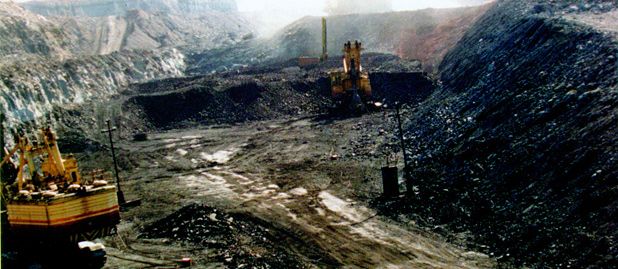|
Coal: Extraction
and Energy Production Impacts on Birds
Coal Mine by USGS
Background
Without proper care, coal mining (both surface and subsurface) can destroy land and pollute water. When coal is then burned to produce energy, it gives off carbon dioxide, the main greenhouse gas that is linked with global warming. Burning coal also produces emissions, such as sulfur, nitrogen oxide, and mercury that can pollute the air and water. In addition, transporting mined coal sometimes requires the construction of roads, railroads, pipelines and other facilities in areas of good bird habitat. Power plants themselves disrupt the environment, and the transmission lines that move the electricity also have their impacts.
Impacts on Birds
The United States has the world's largest known coal reserves, about 267.6 billion short tons. This is enough coal to last approximately 236 years at today's level of use. Coal is mined in 27 states. Wyoming mines the most coal, followed by West Virginia, Kentucky, Pennsylvania, and Texas. Coal is mainly found in three large regions, the Appalachian Coal Region, the Interior Coal Region, and Western Coal Region (which includes the Powder River Basin). Generally, impacts on wildlife have not had a significant effect on the ability to produce coal. For example, the Appalachian region is one of the most biodiverse parts of the country, and important habitat for many migratory birds, including warblers, waterthrushes, and vireos. It is also important to the coal industry. Over 1,200 mines are found in the region. Some 380,574 acres of forest habitat were destroyed for the purpose of mountaintop removal from 1992 to 2002.
One particularly destructive form of mining is called "Mountaintop Removal/Valley Fill" whereby entire tops of mountains are removed to gain access to coal seams. The mountain habitat is devastated in the process, and the dumping of mountain rubble into nearby valleys creates further habitat loss as well as the severe loss of streamwater quality. Mining practices such as this are blamed in part for the decline in the population of the Cerulean Warbler, a small, blue songbird that breeds in the mature forests of the Appalachian Mountains. This migratory species has experienced a 70% decline since 1966. The Louisiana Waterthrush, Worm-eating Warbler, Black-and-white Warbler, and Yellow-throated Vireo are also being threatened by removal of forest habitat. Although mining continues to threaten wild birds across a broad range of habitats, in selected instances, wildlife concerns are limiting the the manner in which coal is mined and the amount of coal that can be extracted. For example, in southern Wyoming, mine plans have had to be adapted for the protection of raptor habitat, especially that related to nesting areas for Golden Eagles. In North Dakota, mining is being restricted in wooded draws, a scarce bird habitat.
Existing Protections for Birds
Protections for birds from coal extraction is based primarily on a federal provision which states that an operation must: ".to the extent possible using the best technology currently available, minimize disturbances and adverse impacts of the operation on fish, wildlife, and related environmental values (which has been understood to mean habitat for birds and other wildlife), and achieve enhancement of such resources where practicable." In addition, operators are required to: design electric power lines and other transmission facilities so as to minimize the potential for electrocution of raptors, protect or restore riparian areas, and refrain from using persistent pesticides. In addition, where bird habitat is to be a primary or secondary post mining land use, an operator must select plant species on reclaimed areas based on their nutritional value and their value as cover, and must distribute these species to optimize habitat. Where cropland is to be established after mining, fields are to be interspersed with "trees, hedges, or fence rows." Unfortunately, there are few protections for birds from the burning of coal to produce electricity and the related effects on global warming. In addition, metal accumulation in passerine bird species has also been found in a zones surrounding coal-fired power plant.
Solutions
One obvious solution to the growth of coal extraction is to push for greater energy conservation and production of renewable energy. Likewise, the adoption of carbon capture and sequestration (CCS) technology can help reduce the carbon dioxide emissions significantly while also allowing coal to meet the world's pressing energy needs. CCS involves trapping carbon dioxide at the point of production and then storing it to prevent its release into the atmosphere. Storage can be in underground formation or in the form of mineral carbonates.
There are few ways to mitigate for the destructive practice of mountaintop removal, with the exception of improved reforestation after the mine has exhausted its coal reserves. |
